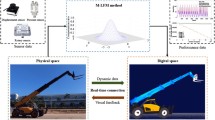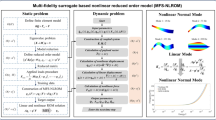Abstract
With the increasing demand for structural visualization, health monitoring, and fault diagnosis, the requirements for real-time and highly accurate digital twins (DTs) to realize interactions between the physical and digital spaces have increased. However, the real-time requirements of DT have become an obstacle to their applications in practical engineering. In this work, a hybrid reduced-order modeling (HROM) method was proposed to improve calculation efficiency and ensure the accuracy of the shape-performance integrated DT (SPI-DT). The proposed method is driven by dynamic sensor data and consisted of the reduced-order model (ROM), the Kriging (KRG) model, and the isoparametric element formulation. It also introduces an iterative infilling strategy to select master degrees of freedom (MDOFs) in this method. In addition, the main beam of a gantry crane was used as a numerical example to verify the accuracy and efficiency of the HROM method. The results show that the online computationally cost online of the HROM method is lower than the KRG and ROM methods, which can improve the computational efficiency of the SPI-DT for complex-large structures by significantly reducing the delay time. Moreover, the HROM method had higher prediction accuracy (R-squared = 0.8986) compared with the KRG method (R-squared = 0.8599) and closer to the ROM method (R-squared = 0.9052) since the HROM method based on the ROM data and the data-driven method. This research provides a feasible method for realizing the applications of DT in major engineering equipment.













Similar content being viewed by others
Data Availability
The datasets generated during and/or analyzed during the current study are available from the corresponding author on reasonable request.
References
Liu S, Bao J, Lu Y, Li J, Lu S, Sun X (2021) Digital twin modeling method based on biomimicry for machining aerospace components. J Manuf Syst 58:180–195
Toso F, Favato A, Torchio R, Carbonieri M, De Soricellis M, Alotto P, Bolognani S (2020) Digital Twin Software for Electrical Machines (Doctoral dissertation, Universita’Degli Studi di Padova)
Grieves M (2014) Digital twin: manufacturing excellence through virtual factory replication. White paper 1:1–7
Grieves M, Vickers J (2017) Digital twin: mitigating unpredictable, undesirable emergent behavior in complex systems. In: Kahlen F, Flumerfelt S, Alves A (eds) Transdisciplinary perspectives on complex systems. Springer, Cham, pp 85–113
He X, Qiu Y, Lai X, Li Z, Shu L, Sun W, Song X (2021) Towards a shape-performance integrated digital twin for lumbar spine analysis. Digit Twin 1(8):8
Ganguli R, Adhikari S (2020) The digital twin of discrete dynamic systems: Initial approaches and future challenges. Appl Math Model 77:1110–1128
Tao F, Zhang H, Liu A, Nee AY (2018) Digital twin in industry: state-of-the-art. IEEE Trans Industr Inf 15(4):2405–2415
Glaessgen E, Stargel D (2012) The digital twin paradigm for future NASA and US Air Force vehicles. In: 53rd AIAA/ASME/ASCE/AHS/ASC structures, Structural Dynamics and Materials Conference 20th AIAA/ASME/AHS adaptive structures conference 14th AIAA, p 1818
Tuegel EJ, Ingraffea AR, Eason TG, Spottswood SM (2011) Reengineering aircraft structural life prediction using a digital twin. Int J Aerosp Eng, 2011: 14-27.
Haag S, Anderl R (2018) Digital twin–Proof of concept. Manuf Lett 15:64–66
Guivarch D, Mermoz E, Marino Y, Sartor M (2019) Creation of helicopter dynamic systems digital twin using multibody simulations. CIRP Ann 68(1):133–136
Honghong S, Gang Y, Haijiang L, Tian Z, Annan J (2023) Digital twin enhanced BIM to shape full life cycle digital transformation for bridge engineering. Autom Constr 147:104736
Lee S, Park S, Kim T, Lieu QX, Lee J (2021) Damage quantification in truss structures by limited sensor-based surrogate model. Appl Acoust 172:107547
Moi T, Cibicik A, Rølvåg T (2020) Digital twin based condition monitoring of a knuckle boom crane: an experimental study. Eng Fail Anal 112:104517
Yu J, Song Y, Tang D, Dai J (2021) A Digital Twin approach based on nonparametric Bayesian network for complex system health monitoring. J Manuf Syst 58:293–304
García-Macías E, Ubertini F (2022) Real-time Bayesian damage identification enabled by sparse PCE-Kriging meta-modelling for continuous SHM of large-scale civil engineering structures. J Build Eng 59:105004
Lai X, Wang S, Guo Z, Zhang C, Sun W, Song X (2021) Designing a shape-performance integrated digital twin based on multiple models and dynamic data: a boom crane example. J Mech Des 143(7):071703
Wang S, Lai X, He X, Qiu Y, Song X (2021) Building a trustworthy product-level shape-performance integrated digital twin with multifidelity surrogate model. J Mech Des 144(3):031703
Rasheed A, San O, Kvamsdal T (2020) Digital twin: values, challenges and enablers from a modeling perspective. Ieee Access 8:21980–22012
Hartmann D, Herz M, Wever U (2018) Model order reduction a key technology for digital twins. In: Keiper W, Milde A, Volkwein S (eds) Reduced-order modeling (ROM) for simulation and optimization. Springer, Cham, pp 167–179
Lee K, Carlberg KT (2020) Model reduction of dynamical systems on nonlinear manifolds using deep convolutional autoencoders. J Comput Phys 404:108973
Kapteyn MG, Knezevic DJ, Huynh DBP, Tran M, Willcox KE (2020) Data‐driven physics‐based digital twins via a library of component‐based reduced‐order models. Int J Numer Methods Eng 123(13): 2986-3003
Abbaszadeh M, Dehghan M, Navon IM (2020) A POD reduced-order model based on spectral Galerkin method for solving the space-fractional Gray–Scott model with error estimate. Eng Comput 38:pp 1–24
Qu ZQ (2004) Model order reduction techniques with applications in finite element analysis: with applications in finite element analysis. Springer Science & Business Media
Guyan RJ (1965) Reduction of stiffness and mass matrices. AIAA J 3(2):380–380
O'Callahan J (1989) A procedure for an improved reduced system (IRS) model. In: Proceedings of 7th IMAC, Las Vegas, NV., 1989
Castanier MP, Tan YC, Pierre C (2001) Characteristic constraint modes for component mode synthesis. AIAA J 39(6):1182–1187
Stabile G, Matthies HG, Borri C (2018) A novel reduced order model for vortex induced vibrations of long flexible cylinders. Ocean Eng 156:191–207
Wang B, Li Y, Hao P, Zhou Y, Zhao Y, Wang B (2017) Free vibration analysis of beam-type structures based on novel reduced-order model. AIAA J 55(9):3143–3152
Kleijnen JP (2009) Kriging metamodeling in simulation: a review. Eur J Oper Res 192(3):707–716
Xu H, Zhang W, Zhou N, Xiao L, Zhang J (2022) An active learning Kriging model with adaptive parameters for reliability analysis. Eng Comput, pp 1–18
Qian J, Yi J, Cheng Y, Liu J, Zhou Q (2020) A sequential constraints updating approach for Kriging surrogate model-assisted engineering optimization design problem. Eng Comput 36:993–1009
Feng S, Hao P, Liu H, Wang B, Wang B, Yue C (2023) A collaborative model calibration framework under uncertainty considering parameter distribution. Comput Methods Appl Mech Eng 404:115841
Bachoc F (2013) Cross validation and maximum likelihood estimations of hyper-parameters of Gaussian processes with model misspecification. Comput Stat Data Anal 66:55–69
Xi C, Zheng H (2021) Improving the generalized Bloch mode synthesis method using algebraic condensation. Comput Methods Appl Mech Eng 379:113758
Boschert S, Rosen R (2016) Digital twin—the simulation aspect. In: Hehenberger P, Bradley D (eds) Mechatronic futures. Springer, Cham, pp 59–74
Chakraborty S, Adhikari S, Ganguli R (2021) The role of surrogate models in the development of digital twins of dynamic systems. Appl Math Model 90:662–681
Kwon K, Frangopol DM (2010) Bridge fatigue reliability assessment using probability density functions of equivalent stress range based on field monitoring data. Int J Fatigue 32(8):1221–1232
Benasciutti D (2014) Some analytical expressions to measure the accuracy of the “equivalent von Mises stress” in vibration multiaxial fatigue. J Sound Vib 333(18):4326–4340
Sidebottom OM (1972) Evaluation of finite-plasticity theories for nonproportionate loading of torsion-tension members: Finite-incremental and total-strain von Mises theories are derived for nonproportionate loading of solid circular torsion-tension members and are compared with test data obtained from members made of either SAE 1045 steel or 7075–76 aluminum alloy. Exp Mech 12:18–24
Roy MJ, Stoyanov N, Moat RJ, Withers PJ (2020) pyCM: An open-source computational framework for residual stress analysis employing the Contour Method. SoftwareX 11:100458
Sowa L, Saternus Z, Kubiak M (2017) Numerical modelling of mechanical phenomena in the gantry crane beam. Proc Eng 177:225–232
Qi Q, Tao F, Hu T, Anwer N, Liu A, Wei Y, Nee AYC (2021) Enabling technologies and tools for digital twin. J Manuf Syst 58:3–21
He X, Lai X, Yang L, Zhang F, Zhou D, Song X, Sun W (2022) M-LFM: a multi-level fusion modeling method for shape-performance integrated digital twin of complex structure. Front Mech Eng 17(4):52
Keane A, Forrester A, Sobester A (2008) Engineering design via surrogate modelling: a practical guide. American Institute of Aeronautics and Astronautics Inc
Newton RE (1973) Degeneration of brick-type isoparametric elements. Int J Numer Methods Eng 7(4):579–581
Acknowledgements
This work was supported by the National Key R&D Program of China (No. 2018YFB1700704) and the National Natural Science Foundation of China (No. 52075068).
Author information
Authors and Affiliations
Corresponding author
Ethics declarations
Conflict of interest
There are no conflicts of interest.
Additional information
Publisher's Note
Springer Nature remains neutral with regard to jurisdictional claims in published maps and institutional affiliations.
Appendix
Appendix
This section introduces the derived formula of the strain transformation matrix. As shown in Fig. 14, combining adjacent nodes can degenerate into a 4 nodes 3D tetrahedral element for a linear 3D hexahedron element with 8 nodes. The processing of equation deducing as follows:
First, the shape functions of linear 3D hexahedron elements as an example can be expressed as follows:
where \(\xi_{1} = - 1,\eta_{1} = - 1,\zeta_{1} = - 1, \ldots ,\xi_{8} = - 1,\eta_{8} = 1,\zeta_{8} = 1\), \(\xi_{K} ,\eta_{K} ,\zeta_{K}\) are the element coordinates system of the node [46]. The coordinates of the node in the linear 3D tetrahedral element can be expressed by the shape function:
The shape function is given in the local coordinate system and according to differentiation:
Similarly, \(\frac{{\partial N_{i} }}{\partial \eta }\) and \(\frac{{\partial N_{i} }}{\partial \zeta }\) can be combined as follows:
where \([{\mathbf{J}}]\) denotes the Jacobian matrix,
The strain transformation matrix can be expressed as:
Rights and permissions
Springer Nature or its licensor (e.g. a society or other partner) holds exclusive rights to this article under a publishing agreement with the author(s) or other rightsholder(s); author self-archiving of the accepted manuscript version of this article is solely governed by the terms of such publishing agreement and applicable law.
About this article
Cite this article
He, X., Lai, X., Li, K. et al. Toward a shape-performance integrated digital twin based on hybrid reduced-order modeling for engineering structures. Engineering with Computers 40, 1157–1175 (2024). https://doi.org/10.1007/s00366-023-01862-3
Received:
Accepted:
Published:
Issue Date:
DOI: https://doi.org/10.1007/s00366-023-01862-3





